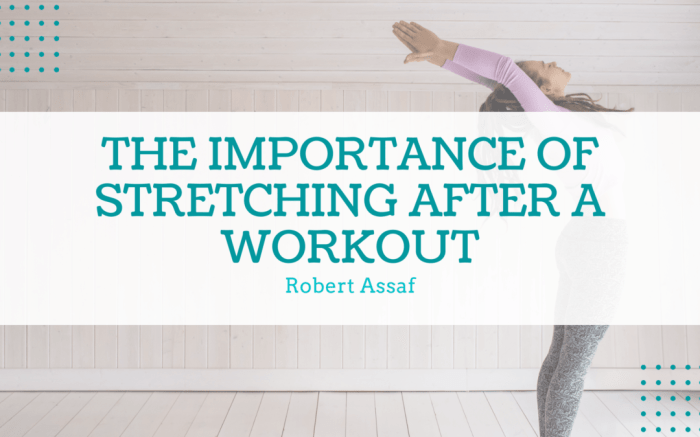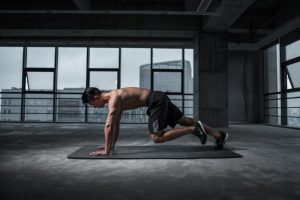
Stepping off the treadmill or ending a weightlifting session, you might feel the urge to collapse on the couch. But hold on! While your body deserves a break, it also needs some TLC. That’s where stretching comes in. It’s not just about feeling limber; it’s a crucial step in maximizing your workout gains and preventing injuries.
Stretching after a workout helps your muscles recover faster, improves flexibility, and can even make you less prone to aches and pains. This article delves into the science behind stretching and offers practical tips for incorporating it into your routine.
Benefits of Stretching After Workouts
Stretching after your workout is a vital part of your fitness routine. It helps your body recover from the exertion, improves flexibility, and reduces the risk of injuries.
Muscle Recovery and Soreness Reduction
Stretching plays a crucial role in muscle recovery. During exercise, your muscles experience microscopic tears, which are the source of post-workout soreness. Stretching helps to increase blood flow to the muscles, which delivers nutrients and oxygen necessary for repair. This process also removes metabolic byproducts that accumulate during exercise, leading to reduced muscle soreness.
Improved Flexibility and Range of Motion
Stretching enhances flexibility and range of motion by increasing the elasticity of muscles and tendons. This allows for a greater range of movement, improving overall mobility and performance in daily activities and sports.
Injury Prevention
Stretching can significantly reduce the risk of injuries by improving muscle flexibility and range of motion. When muscles are flexible, they are better equipped to handle stress and strain, reducing the likelihood of strains, sprains, and other musculoskeletal injuries.
Effects of Static and Dynamic Stretching
Static Stretching
Static stretching involves holding a stretch for a prolonged period, typically 15-30 seconds. This type of stretching is known to improve flexibility and range of motion, but it can also temporarily decrease muscle power and performance if done before a workout.
Dynamic Stretching
Dynamic stretching involves controlled movements through a range of motion, such as arm circles or leg swings. This type of stretching is more beneficial for preparing the body for exercise, as it increases blood flow and muscle temperature without compromising muscle power.
Types of Stretches for Post-Workout Recovery
Stretching after a workout is crucial for improving flexibility, reducing muscle soreness, and enhancing overall recovery. It helps to restore muscle length, increase range of motion, and promote blood flow to the muscles. By incorporating a variety of stretches into your post-workout routine, you can optimize your body’s ability to recover and prepare for your next training session.
Stretches for Legs
Stretching your legs after a workout is essential for improving flexibility and reducing muscle soreness in the quadriceps, hamstrings, and calves. These muscle groups are often heavily engaged during activities like running, cycling, and weightlifting.
- Quadriceps Stretch: Stand with your feet hip-width apart and grab one foot with the same hand. Gently pull your heel towards your buttock, keeping your knee aligned with your toes. Hold for 30 seconds and repeat on the other side.
- Hamstring Stretch: Sit on the floor with your legs extended in front of you. Reach towards your toes, keeping your back straight. Hold for 30 seconds and repeat several times.
- Calf Stretch: Stand facing a wall with your feet shoulder-width apart. Step back with one leg, keeping your heel on the ground. Lean into the stretch, keeping your back straight, and hold for 30 seconds. Repeat on the other side.
Stretches for Back
Stretching your back after a workout can help to improve posture, reduce stiffness, and prevent injuries. These stretches target the muscles in your upper back, lower back, and spinal erectors.
- Cat-Cow Stretch: Start on your hands and knees, with your back flat. Inhale and arch your back, dropping your belly towards the floor. Exhale and round your spine, tucking your chin to your chest. Repeat 5-10 times.
- Child’s Pose: Kneel on the floor with your knees wider than hip-width apart. Sit back on your heels and fold forward, resting your forehead on the floor. Extend your arms out in front of you and hold for 30 seconds.
- Knee-to-Chest Stretch: Lie on your back with your knees bent and feet flat on the floor. Bring one knee towards your chest, keeping your back flat on the floor. Hold for 30 seconds and repeat on the other side.
Stretches for Shoulders
Stretching your shoulders after a workout is important for maintaining mobility and reducing tightness in the rotator cuff muscles. These stretches can also help to improve posture and reduce the risk of shoulder injuries.
- Cross-Body Shoulder Stretch: Grab one arm above your elbow with your opposite hand and pull it across your chest. Hold for 30 seconds and repeat on the other side.
- Overhead Triceps Stretch: Reach one arm overhead and bend your elbow, placing your hand between your shoulder blades. Use your opposite hand to gently pull your elbow towards your head. Hold for 30 seconds and repeat on the other side.
- Shoulder Blade Squeeze: Sit or stand with your arms at your sides. Squeeze your shoulder blades together and hold for 5 seconds. Repeat 10 times.
Incorporating Stretching into a Post-Workout Routine
It’s recommended to stretch for at least 5-10 minutes after each workout. Begin with gentle stretches and gradually increase the intensity and duration as your flexibility improves.
- Warm Up: Before stretching, it’s essential to warm up your muscles with light cardio, such as walking or jogging, for 5-10 minutes.
- Target Muscle Groups: Focus on stretching the muscle groups that were primarily used during your workout.
- Hold and Breathe: Hold each stretch for 30 seconds, breathing deeply and focusing on the feeling of the stretch.
- Listen to Your Body: Don’t push yourself beyond your limits. Stop if you feel any pain.
Factors Affecting Stretching Effectiveness

Stretching after a workout is an important part of post-workout recovery. However, various factors can influence how effective your stretches are. Understanding these factors can help you optimize your stretching routine and maximize the benefits for your body.
Proper Warm-Up Before Stretching
A proper warm-up is crucial before stretching. It prepares your muscles for stretching by increasing blood flow and muscle temperature. This makes your muscles more pliable and less susceptible to injury.
A warm-up should consist of light cardio, such as jogging or jumping jacks, followed by dynamic stretches, which involve controlled movements through a range of motion.
Dynamic stretches mimic the movements of your workout, further preparing your muscles for stretching. For example, if you’ve been running, you might include arm circles, leg swings, and torso twists in your warm-up.
Role of Hydration and Nutrition in Post-Workout Recovery
Hydration and nutrition play a vital role in post-workout recovery, directly impacting your stretching effectiveness.
- Hydration: Dehydration can lead to muscle stiffness and soreness, making stretching less effective and potentially increasing the risk of injury. Ensuring adequate hydration before, during, and after your workout is crucial.
- Nutrition: Consuming a balanced diet rich in protein and carbohydrates helps your muscles repair and rebuild after exercise. This improves muscle flexibility and allows for more effective stretching.
Potential Risks Associated with Overstretching
Overstretching, pushing your muscles beyond their normal range of motion, can lead to injury.
- Muscle Tears: Excessive stretching can cause muscle tears, especially if your muscles are not properly warmed up.
- Ligament Damage: Stretching beyond your limits can also damage ligaments, the tissues that connect bones.
- Joint Instability: Overstretching can compromise joint stability, making you more susceptible to sprains and dislocations.
It’s essential to listen to your body and stop if you feel any pain.
Influence of Individual Fitness Levels on Stretching Routines
Your fitness level significantly influences how you approach stretching.
- Beginners: Beginners should start with gentle stretches and gradually increase the intensity and duration as their flexibility improves.
- Experienced Athletes: Experienced athletes may benefit from more intense stretching routines, including deeper stretches and longer hold times. However, they should still prioritize proper form and avoid overstretching.
It’s always advisable to consult a fitness professional or physical therapist for personalized stretching recommendations based on your individual needs and fitness level.
Integrating Stretching into Workout Regimen
Stretching after a workout is crucial for enhancing flexibility, improving recovery, and preventing injuries. Integrating stretching into your workout routine can be achieved through strategic planning and consistent practice.
Sample Post-Workout Stretching Routine
A structured post-workout stretching routine can be a valuable addition to your exercise regimen. Here’s a sample routine for a typical exercise session:
- Dynamic Stretching: This involves controlled movements that warm up your muscles and prepare them for stretching. Examples include arm circles, leg swings, and torso twists.
- Static Stretching: This involves holding a stretch for a period of time, typically 15-30 seconds. Focus on major muscle groups, including your legs, arms, back, and shoulders.
- Yoga or Pilates: Incorporating yoga or Pilates poses can provide a comprehensive stretch for the entire body. These practices promote flexibility, balance, and core strength.
Tips for Incorporating Stretching into Daily Activities
Stretching doesn’t have to be a separate activity. You can easily incorporate it into your daily routine:
- Stretching While Watching TV: Instead of sitting on the couch, use this time to stretch your legs, arms, and back.
- Stretching During Work Breaks: Take short breaks throughout the day to stretch your neck, shoulders, and wrists, especially if you have a desk job.
- Stretching Before Bed: A few gentle stretches before bed can help relax your muscles and improve your sleep quality.
Structured Stretching Plan
A visual representation of a structured stretching plan can help you stay organized and track your progress.
| Day | Stretching Focus | Duration |
|---|---|---|
| Monday | Legs and Back | 15 minutes |
| Tuesday | Arms and Shoulders | 10 minutes |
| Wednesday | Full Body | 20 minutes |
| Thursday | Legs and Back | 15 minutes |
| Friday | Arms and Shoulders | 10 minutes |
| Saturday | Rest | – |
| Sunday | Yoga or Pilates | 30 minutes |
Consistency and Gradual Progression in Stretching Routines
Consistency is key to achieving lasting improvements in flexibility.
“Regular stretching can improve your range of motion, reduce muscle soreness, and help prevent injuries.”
Start with a gentle routine and gradually increase the duration and intensity of your stretches over time. This gradual progression allows your muscles to adapt and prevents overstretching.
Food and Related Products
After a challenging workout, your body needs nourishment to repair and rebuild muscle tissue, replenish energy stores, and prepare for the next session. What you eat plays a crucial role in how effectively your body recovers and adapts to the demands of exercise.
The Role of Protein in Muscle Repair
Protein is essential for muscle growth and repair. During exercise, muscle fibers experience microscopic tears. These tears are a natural part of the process that leads to muscle adaptation and strength gains. To repair these tears and build new muscle tissue, your body needs a sufficient supply of protein.
Consuming adequate protein after exercise helps your body synthesize new muscle proteins, leading to muscle hypertrophy (growth) and improved performance.
Foods that Promote Muscle Recovery and Flexibility
A balanced diet rich in protein, carbohydrates, and healthy fats is vital for optimal recovery.
- Protein Sources: Lean meats (chicken, turkey, fish), eggs, dairy products (milk, yogurt, cheese), beans, lentils, tofu, and protein powders.
- Carbohydrates: Complex carbohydrates, such as whole grains, fruits, and vegetables, provide energy for muscle recovery and replenishment of glycogen stores.
- Healthy Fats: Monounsaturated and polyunsaturated fats found in avocados, nuts, seeds, and olive oil support hormone production and cell function, aiding in recovery.
Sample Meal Plan
Here is a sample meal plan that incorporates foods beneficial for post-workout stretching:
| Meal | Food Options | Benefits |
|---|---|---|
| Post-Workout Snack | Greek yogurt with berries and a handful of almonds | Provides protein, carbohydrates, and healthy fats for muscle recovery and energy replenishment. |
| Lunch | Grilled salmon with quinoa and steamed broccoli | Rich in protein, complex carbohydrates, and antioxidants to support muscle repair and overall health. |
| Dinner | Chicken breast stir-fry with brown rice and mixed vegetables | Offers a balance of protein, carbohydrates, and vitamins for muscle recovery and energy restoration. |
Product Creation

The growing awareness of the importance of stretching after workouts has opened up a lucrative market for products designed to enhance post-workout recovery. This section explores potential product ideas, a prototype for a stretching device, marketing and distribution strategies, and analyzes the potential market demand for stretching-related products.
Potential Product Ideas
There are various product ideas that can cater to the needs of individuals seeking to improve their post-workout stretching routines. Here are some examples:
- Stretching Bands: These bands offer resistance and support during stretches, helping users achieve greater flexibility and range of motion. Different resistance levels can cater to various fitness levels.
- Foam Rollers: These cylindrical tools are used for self-massage and myofascial release, helping to alleviate muscle tension and soreness. Specialized foam rollers with textured surfaces can target specific muscle groups.
- Smart Stretching Devices: These devices integrate technology to guide users through stretching exercises, providing real-time feedback on form and progress. They can also offer personalized stretching programs based on individual needs and goals.
- Stretching Apps: Mobile applications can offer a wide range of stretching routines, guided by videos and instructions. Some apps can track progress and provide personalized recommendations.
- Interactive Stretching Mirrors: These mirrors can display real-time feedback on stretching form and provide guidance on proper technique. They can also integrate with smart devices to track progress and offer personalized recommendations.
Prototype Design for a Stretching Device
Imagine a portable stretching device that combines the benefits of a foam roller and a stretching band. This device, named “FlexFit,” consists of a lightweight, adjustable foam roller with integrated resistance bands. The roller can be used for self-massage and myofascial release, while the bands provide resistance for dynamic stretching exercises. The device is designed to be user-friendly, with adjustable resistance levels and clear instructions for various stretches.
It can be used at home, the gym, or on the go, making it a convenient tool for post-workout recovery.
Marketing and Distribution Strategies
To effectively market and distribute stretching-related products, it is crucial to target the right audience and utilize appropriate channels. Here are some key strategies:
- Target Audience: The target audience includes fitness enthusiasts, athletes, individuals with sedentary lifestyles, and those seeking to improve flexibility and mobility.
- Marketing Channels: Online platforms like social media, fitness blogs, and e-commerce websites are essential for reaching the target audience. Collaborations with fitness influencers and trainers can enhance brand awareness.
- Distribution Channels: Products can be distributed through online retailers, fitness stores, and gyms. Partnerships with fitness centers and wellness studios can provide access to a wider customer base.
Market Demand for Stretching-Related Products
The demand for stretching-related products is on the rise due to increasing awareness of the benefits of post-workout recovery and the growing popularity of fitness and wellness activities.
- Increased Focus on Recovery: Athletes and fitness enthusiasts are prioritizing recovery to prevent injuries and enhance performance. Stretching products offer a convenient and effective way to achieve this.
- Growing Demand for Convenience: Individuals with busy lifestyles seek convenient solutions for post-workout recovery. Portable and user-friendly stretching devices meet this demand.
- Emerging Trends in Wellness: The rise of mindfulness and self-care practices has led to increased interest in stretching and flexibility exercises. This creates a growing market for stretching-related products.
Bed and Breakfast Inns
Bed and breakfast inns, with their cozy charm and personalized service, are increasingly seeking ways to enhance the guest experience and promote wellness. Incorporating stretching routines into their offerings can be a valuable addition, catering to the growing demand for fitness and relaxation.
Benefits of Stretching for Bed and Breakfast Guests
Stretching offers numerous benefits for guests at bed and breakfast inns, promoting both physical well-being and mental relaxation. Regular stretching can help improve flexibility, reduce muscle soreness, enhance posture, and alleviate stress.
- Improved Flexibility and Range of Motion: Stretching helps lengthen muscles, increasing flexibility and range of motion, which can be particularly beneficial after long car rides or flights.
- Reduced Muscle Soreness: Post-workout stretching can help reduce muscle soreness and stiffness, allowing guests to enjoy their stay without discomfort.
- Enhanced Posture: Stretching can improve posture by strengthening core muscles and promoting proper alignment, leading to a more confident and comfortable experience.
- Stress Relief and Relaxation: Stretching can promote relaxation and reduce stress levels, contributing to a more peaceful and enjoyable stay.
Promotional Packages
Bed and breakfast inns can create attractive promotional packages that integrate stretching services or resources. These packages can cater to different needs and preferences, offering a holistic wellness experience.
- “Stretch and Relax” Package: This package can include a complimentary stretching session with a certified instructor, access to a dedicated stretching area, and relaxation amenities like aromatherapy oils or herbal teas.
- “Active Traveler” Package: This package can cater to active travelers by providing guided stretching routines, fitness equipment, and access to nearby hiking trails or walking paths.
- “Mind and Body Renewal” Package: This package can focus on both physical and mental well-being by offering a combination of stretching sessions, meditation sessions, and spa treatments.
Creating a Relaxing and Wellness-Focused Atmosphere
To enhance the wellness experience, bed and breakfast inns can create a relaxing and inviting atmosphere.
- Dedicated Stretching Area: Designate a dedicated space for stretching, equipped with comfortable mats, blocks, and straps. This space should be well-lit, airy, and calming.
- Relaxing Ambiance: Incorporate elements that promote relaxation, such as soft lighting, soothing music, and calming decor. Consider using natural materials like wood and bamboo to create a warm and inviting atmosphere.
- Wellness Amenities: Offer amenities that support wellness, such as herbal teas, healthy snacks, and access to meditation apps or guided relaxation videos.
- Staff Training: Train staff to provide information about stretching benefits and to guide guests to the designated stretching area.
Examples of Successful Bed and Breakfast Inns
Several bed and breakfast inns have successfully integrated stretching into their offerings.
- The Wellness Retreat Inn: This inn offers a dedicated yoga and stretching studio, along with wellness packages that include guided stretching sessions and healthy meals.
- The Mountain View Inn: This inn provides complimentary stretching mats and access to a nearby hiking trail, encouraging guests to engage in physical activity and stretch after their outdoor adventures.
- The Coastal Serenity Inn: This inn features a serene meditation garden and offers guided stretching sessions by certified instructors, creating a relaxing and rejuvenating experience for guests.
Cooking and Culinary
Fueling your body with the right nutrients is crucial for post-workout recovery and enhancing flexibility. A well-planned diet can help your muscles rebuild, reduce inflammation, and support optimal stretching. Here’s how you can incorporate cooking and culinary practices to aid your recovery journey.
Recipes for Post-Workout Recovery
The following recipes provide examples of healthy snacks and meals that can support your post-workout recovery. * Protein Smoothie: Blend together 1 cup of frozen fruit (berries, bananas, or mangoes), 1 scoop of protein powder, 1/2 cup of milk or yogurt, and a handful of spinach. This smoothie provides a quick and convenient source of protein and carbohydrates to help repair muscles and replenish energy.
Grilled Salmon with Roasted Vegetables
Grilled salmon is a great source of omega-3 fatty acids, which can help reduce inflammation and improve muscle recovery. Pair it with roasted vegetables like broccoli, sweet potatoes, or asparagus for a balanced and nutritious meal.
Chicken Stir-Fry
Chicken stir-fry is a quick and easy meal that’s packed with protein and nutrients. Use lean chicken breast, a variety of colorful vegetables, and a light sauce to create a delicious and healthy dish.
Culinary Experience Incorporating Stretching Techniques
Imagine a culinary experience that combines the joy of cooking with the benefits of stretching. Here’s how you can create a unique and enriching experience:* Stretching Breaks: Incorporate short stretching breaks throughout the cooking process. For example, while waiting for a pot to boil, you can perform some gentle arm circles or shoulder rolls. This helps keep your body moving and prevents stiffness.
Stretching-Inspired Dishes
Create dishes that are inspired by stretching movements. For example, a “butterfly” salad with butterfly-shaped vegetables or a “cobra” pasta dish that resembles the cobra yoga pose.
Mindful Eating
Practice mindful eating during your meal, paying attention to the flavors and textures of your food. This can help you relax and connect with your body, promoting a sense of well-being.
Role of Food in Enhancing Flexibility and Muscle Recovery
The food you eat plays a vital role in enhancing flexibility and muscle recovery. Here’s how:* Protein: Protein is essential for muscle growth and repair. Consume adequate protein after your workouts to support muscle recovery and prevent muscle soreness.
Carbohydrates
Carbohydrates provide energy for your workouts and help replenish glycogen stores in your muscles. Choose complex carbohydrates, such as whole grains, fruits, and vegetables, for sustained energy levels.
Hydration
Water is crucial for maintaining hydration levels, which is essential for optimal muscle function and flexibility. Drink plenty of water throughout the day, especially after workouts.
Tips for Preparing Meals that Promote Healthy Stretching Habits
Here are some tips for preparing meals that encourage healthy stretching habits:* Plan Your Meals: Plan your meals in advance to ensure you have healthy and nutritious options readily available.
Cook in Bulk
Cook in bulk and freeze portions for easy meal prep throughout the week.
Use a Food Journal
Keep a food journal to track your intake and identify areas where you can improve your nutrition.
Incorporate Stretching into Meal Prep
Include short stretching breaks during meal preparation, such as stretching your arms while stirring or your legs while chopping vegetables.
Eat Mindfully
Pay attention to your body’s cues and eat when you’re truly hungry. Stop eating when you’re satisfied, not stuffed.
Stretching isn’t just an afterthought; it’s a powerful tool for enhancing your fitness journey. By dedicating a few minutes to stretching after each workout, you can unlock a world of benefits, from improved performance to a reduced risk of injuries. Remember, a little flexibility goes a long way towards a healthier and more resilient you.
FAQ
Is stretching necessary after every workout?
While stretching after every workout is beneficial, it’s especially important after intense or strenuous exercise. If you have a lighter workout, a quick stretch might suffice.
How long should I stretch after a workout?
Aim for 5-10 minutes of stretching after your workout. Focus on each muscle group, holding stretches for 15-30 seconds.
Can I stretch before a workout?
Yes, stretching before a workout can help prepare your muscles for activity. However, it’s best to focus on dynamic stretches, which involve controlled movements, rather than static stretches, which involve holding positions.
What if I feel pain while stretching?
If you experience pain while stretching, stop immediately. Pain is a signal that you’re pushing your body too far. Focus on gentle stretches and gradually increase the intensity as you improve flexibility.






